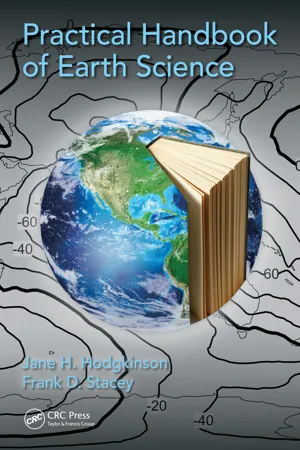
This is a test
- 402 pages
- English
- ePUB (mobile friendly)
- Available on iOS & Android
eBook - ePub
Practical Handbook of Earth Science
Book details
Book preview
Table of contents
Citations
About This Book
This self-contained handbook provides a carefully researched, compact source of key earth science information and data, logically sorted by subject matter, and then cross-referenced. Appealing to both experts and non-experts alike, the book presents earth science and environmental science as closely intertwined. It includes tables of the global distributions of fossil fuels, contrasted by tables of the distribution of non-fossil energy sources. Concise explanations cover the subject matters of geology, geophysics, oceans, atmosphere with attention to environmental implications and resources.
Frequently asked questions
At the moment all of our mobile-responsive ePub books are available to download via the app. Most of our PDFs are also available to download and we're working on making the final remaining ones downloadable now. Learn more here.
Both plans give you full access to the library and all of Perlego’s features. The only differences are the price and subscription period: With the annual plan you’ll save around 30% compared to 12 months on the monthly plan.
We are an online textbook subscription service, where you can get access to an entire online library for less than the price of a single book per month. With over 1 million books across 1000+ topics, we’ve got you covered! Learn more here.
Look out for the read-aloud symbol on your next book to see if you can listen to it. The read-aloud tool reads text aloud for you, highlighting the text as it is being read. You can pause it, speed it up and slow it down. Learn more here.
Yes, you can access Practical Handbook of Earth Science by Jane Hodgkinson, Frank Stacey in PDF and/or ePUB format, as well as other popular books in Biological Sciences & Environmental Conservation & Protection. We have over one million books available in our catalogue for you to explore.
Information
Section VI
Rocks and Minerals
Chapter 19
Mineral Types and Characteristics
19.1 DESCRIPTIVE TERMS
Various features of minerals are used to describe and identify them. In a hand specimen, diagnostic properties, defined in the following subsections (Tables 19.1 through 19.8 and 19.11 through 19.20), are colour, streak, Mohs hardness, fracture, cleavage, habit, lustre and specific gravity.
19.1.1 Colour of Mineral in Hand Specimen
As the word implies, a hand specimen of rock or mineral is typically of a size that will fit in the hand. To be useful, it must have a freshly broken surface that exposes unweathered grains. Colour is simply a general description of light reflected from the surface, which is often different from the colour seen in unpolarised transmitted light (in thin-section under a microscope).
19.1.2 Mohs Hardness
The scale proposed in 1812 by the mineralogist Friedrich Mohs is a relative scale of scratch resistance of minerals judged by the fact that harder materials visibly scratch softer ones in hand specimens. Type specimens are used to specify the hardness scale from 1 (softest) to 10 (hardest) (Table 19.1) and common, readily available materials are generally used (Table 19.2).
TABLE 19.1 THE MOHS HARDNESS SCALE | |
|---|---|
Mohs Hardness | Index Mineral |
1 | Talc |
2 | Gypsum |
3 | Calcite |
4 | Fluorite |
5 | Apatite |
6 | Orthoclase feldspar |
7 | Quartz |
8 | Topaz |
9 | Corundum |
10 | Diamond |
TABLE 19.2 COMMON ITEMS USED FOR TESTING HARDNESS | |
|---|---|
Hardness | Material |
2–3 | Finger nail |
3 | Copper coin |
5–6 | Knife blade |
6 | Broken glass |
7 | Steel file |
19.1.3 Streak
If a mineral specimen is scratched on an unglazed porcelain plate (‘streak plate’), the colour of the resulting fine powder is its ‘streak’, which may be different from both the colours in reflected light and in ...
Table of contents
- Title Page
- Copyright Page
- Table of Contents
- Preface
- Authors
- Section I: Notation and Units
- Section II: The Building Blocks: Elements to Planets
- Section III: Global Geophysics
- Section IV: Major Subdivisions of the Earth: Structures and Properties
- Section V: Geological Activity: The Restless Earth
- Section VI: Rocks and Minerals
- Section VII: Resources
- References
- Index